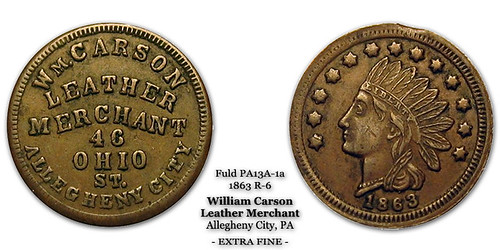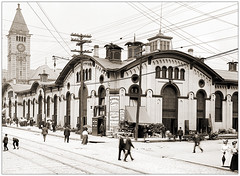
PREV ARTICLE
NEXT ARTICLE
FULL ISSUE
PREV FULL ISSUE
CIVIL WAR TOKENS OF ALLEGHENY CITYAaron Packard's Nova Numismatics site holds a wonderful collection of articles
on U.S. tokens, from colonial times onward. He recently discovered an article I'd published
back in 1984 in the Civil War Token Society’s Copperhead Courier on the tokens of Allegheny
City, PA. My article was mainly about the history of the town. Aaron has not only republished it,
but added new illustrations and expanded it to include a table of all Allegheny City CWT varieties.
It looks great! Here’s an excerpt. -Editor
 Allegheny City was located just across the Allegheny River from downtown Pittsburgh, PA. It is now known simply as “the North Side” (See figure 1). Allegheny was long ago absorbed by the growing city of Pittsburgh, but its memory lives on. The Civil War Tokens of six merchants are part of the numismatic legacy of Allegheny City. This article is a short history of their town. The U.S. Census of 1810 recorded approximately 450 residents of Allegheny Town. They were mostly Presbyterian settlers who farmed and manufactured such items as glass and rope. An 1825 visitor described “… a little village called Allegheny Town, laid out upon a grand scale, but on account of the proximity of Pittsburgh, it will with difficulty attain any importance.”
In 1864 a Sanitary Fair was held to raise money for the “subsistence and hospitalization of Union Soldiers and their dependents.” The organizers requested donations of things which could be “eaten, worn, sold, or were curious to look at.” A new City Hall building was nearly complete, and it was decided to tear down the old Town House ahead of schedule to make room for the Fair. City Council declared that a photograph of the historic structure be taken and 200 copies be given to the Fair, presumably to be sold as souvenirs. The Sanitary Fair opened on June 1st, 1864. Buildings included Floral Hall, Exhibition Hall, Mechanics Hall, Ladies Bazaar, and the Refectory. The Fair raised $363,000 for the soldiers. Pittsburgh politicians long yearned to control Allegheny City. Allegheny City, of course, clung tightly to her independence, and would have no part of her crowded neighbor across the river. As early as 1867 Pittsburgh moved to incorporate outlying districts. By 1905 however, the political climate began to change. Proponents of Pittsburgh’s annexation scheme had the ear of the new Governor, Samuel W. Pennypacker. A bill was rushed to the State Legislature, and passed on February 7, 1906. The bill allowed for two municipalities to merge if agreed to by a majority of the ENTIRE population of the two areas. An election was quickly held, and Pittsburgh having a far greater population than its neighbor, the outcome was inevitable. The vote was two-to-one in favor of annexation, despite the wishes of 70% of Allegheny City voters. Allegheny was proud of her existence, and her death struggles were severe. A series of appeals went all the way to the U.S. Supreme Court; all failed. On December 6, 1907, by order of the Supreme Court of Pennsylvania, the consolidation was complete. Allegheny City was no more. To read the complete article, see:
Wayne Homren, Editor The Numismatic Bibliomania Society is a non-profit organization promoting numismatic literature. See our web site at coinbooks.org. To submit items for publication in The E-Sylum, write to the Editor at this address: whomren@gmail.com To subscribe go to: https://my.binhost.com/lists/listinfo/esylum All Rights Reserved. NBS Home Page Contact the NBS webmaster 
|
